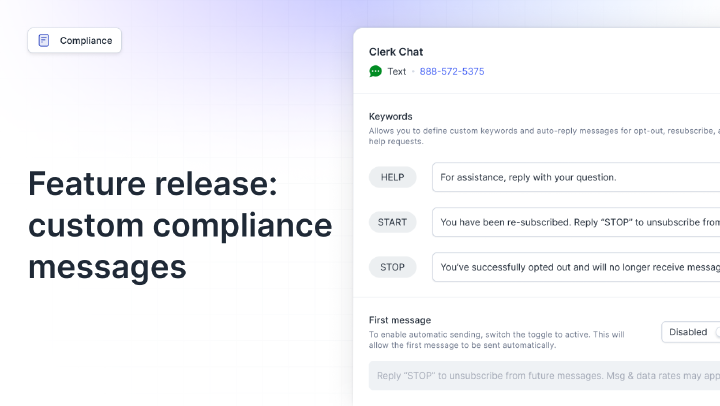Benefits and Best Practices for AI in Customer Service
By Team Clerk Chat
- Published: November 29, 2024
Welcome to the new era of AI in customer service, where companies aren’t just using intelligent tools for predictive analytics and forecasting – they’re leveraging AI to transform full customer journeys.
Thanks to new evolutions in machine learning algorithms, generative and conversational AI technology, and automation, the potential for artificial intelligence in Customer Experience (CX) has skyrocketed. Companies in every industry are getting involved.
Ecommerce and retail brands use AI to help guide customers towards relevant products. Airlines use AI to streamline check-ins and predict delays. Even hospitality brands use AI to help customers make reservations, plan trips, and make the most of various services.
However, many leaders believe AI will have a transformative impact on their customer service strategy, there are still hurdles to overcome. You still need to know how to identify the right tools to use in your strategy, and how to find the balance between human and machine support.
Here’s your guide to mastering AI for customer service.
Could AI be your secret ingredient to exceptional customer service?
Learn moreImmediacy + efficiency
Smart, instant, + personalized
Interactive conversations
Improve response times
What is AI in Customer Service?
AI in customer service is the process of using artificial intelligence (AI), machine learning, and other intelligent systems to improve customer support operations. It’s all about taking advantage of cutting-edge technology to make customer service experiences more efficient, personalized, and seamless.
While companies have been using AI for call center and customer service tasks, like analyzing data and assessing performance metrics, the potential of this technology has grown in recent years.
We now have AI tools for customer service that can learn from previous interactions and data, using machine learning and deep learning models, to enhance their performance over time. We have conversational messaging bots that use generative AI, natural language processing, and machine learning to respond to more complex requests, and complete a range of tasks autonomously.
There are even AI tools designed to automate proactive interactions with customers. For instance, an AI system can send promotional text messaging campaigns to customers when new products are released, based on their previous purchases or preferences.
AI: More than Just Customer Service Automation
Notably, customer service AI solutions aren’t just tools for “automating” customer service processes. Chatbots have been able to automate tasks like answering common questions for years. However, as you’ll know if you’ve read our chatbot vs conversational AI guide, traditional chatbots weren’t “intelligent,” they just followed pre-set rules to complete tasks.
AI customer service tools draw on real-time and historical data to intelligently solve problems. To put this into context, a standard automation tool could send an automated text message to a customer when they purchase a product from your store.
An AI bot, on the other hand, could dive into data about a customer’s order to answer questions about when the product might arrive, or provide suggestions on complimentary products they might like.

The Benefits of AI in Customer Service
Most of the benefits of AI in customer service revolve around the ability AI tools have to improve customer experiences. Using conversational AI for customer service, for instance, allows companies to deliver 24/7 support to customers around the world, preventing them from having to wait hours for a response to a query.
Intelligent tools can also personalize customer experiences, delivering more relevant answers to questions based on their history, location, and more. Beyond enhancing customer experiences with always-on support and personalization, using AI for customer service can:
- Reduce costs: AI can help to reduce customer service costs by automating tasks for employees. This means support teams have more time to resolve more issues, with fewer resources, and it can mean employers spend less money on labor.
- Increase customer loyalty: With AI, companies can increase customer loyalty by delivering more personalized, efficient, and convenient support experiences. They can ensure they can adapt rapidly to changes in demand, and even take a proactive approach to supporting customers with AI-powered text messaging.
- Enhance employee experiences: Since AI helps to reduce the amount of repetitive, mundane tasks employees need to do, it can significantly improve employee morale. In fact, up to 79% of IT leaders believe generative AI can help reduce the risk of burnout.
- Increase productivity and efficiency: AI not only reduces mundane tasks for employees, but it can also provide insights to business leaders that can help them improve resource allocation, ensuring customer service teams operate smoothly.
- Reduce risk: Embedding AI into customer experience strategies can also help to reduce risk. AI solutions can monitor interactions for signs of suspicious activities, and even help with authenticating customers based on biometric data.
Examples of AI in Customer Service
As AI technologies become more advanced and accessible, the number of examples of AI in customer service is growing. Just some of the most common ways companies are using artificial intelligence to improve customer service include:
Chatbots and Virtual Agents
As mentioned above, while chatbots have been around for a while, making it easier for companies to deliver 24/7 service to customers, they haven’t always been as efficient as they are today. Previous chatbots could only respond with basic queries with canned responses.
Now, advanced AI algorithms allow bots to interact with customers in a more human way, delivering personalized answers to questions, and empathetic support. In fact, more than two thirds of CX leaders now believe that AI can help them provide customers with “consistent” and warm service.
Could AI be your secret ingredient to exceptional customer service?
Learn moreImmediacy + efficiency
Smart, instant, + personalized
Interactive conversations
Improve response times
Conversational and generative AI tools can handle more support tasks and requests than ever before. For instance, with conversational AI in financial services, a bank could provide customers with insights into useful products based on their budget and financial goals or answer questions about investment options.
Agent Assistant Tools
Agent assist bots are a type of chatbot or virtual agent designed to support contact center and customer service professionals. They can help team members customize text messages and responses to customers by instantly surfacing data or generating recommended responses. They can even complete tasks for agents automatically, like transcribing calls or conversations.
With AI, companies can give their team members access to intelligent copilots that can help them troubleshoot issues faster, adapt to changes in customer sentiment, and deliver more personalized service. Some solutions can even deliver real-time coaching based on performance metrics, helping staff members to improve their efficiency over time.
Intelligent Routing Systems
Intelligent routing systems are an example of how companies can use AI in customer service to automate everyday tasks. AI solutions with built-in speech recognition and natural language processing capabilities can identify the intent and purpose behind a customer query, then match a caller or a person sending a message to the ideal agent.
These systems can route requests based on factors like urgency, agent skill or availability, or even insights into agents a customer has interacted with previously. Some AI systems can even summarize conversations from previous channels and pass them over to agents during the routing process, ensuring they have direct insights into the context of a discussion.
AI Workforce Management Tools
In the customer service landscape, resource allocation can be difficult to manage, particularly in an age of hybrid and remote work. AI workforce management tools are great for ensuring businesses can make the most out of their resources.
By analyzing historical data, these tools can predict staffing needs for specific days, weeks, months, and seasons, and suggest workplace schedules. They can even track important performance metrics, and provide insights into which team members need additional training and support.
Plus, AI built into a workforce management (WFM) tool can track levels of customer engagement too, automatically source feedback from staff members, and improve workplace morale.
AI Analytical Tools
Intelligent analytical tools are among the most common examples of how companies use AI for customer service. These solutions don’t just gather data, they analyze huge volumes of information to help businesses proactively improve results.
For instance, AI in an SMS customer service platform like Clerk Chat can use historical data about customer interactions to anticipate future customer needs, behavior patterns, and issues. This means companies can more proactively address customer concerns.
AI technologies built into customer service tools can also monitor and analyze customer feedback, track tone and language in customer queries, and offer insights into customer sentiment. This can help businesses identify customers at risk of churn, and find new ways to delight their audience.
AI Content Generation Solutions
Generative AI is excellent at rapidly creating high-quality, personalized content to share with customers. It’s not just great for marketing purposes, it can be valuable in a customer service capacity too. Generative AI tools can rapidly create content for FAQs and knowledge bases, improving your company’s self-service strategy.
AI bots can rapidly fill out texting templates with personalized messages based on customer data, AI can even create content for sales teams in the contact center, designing pitch decks or sales scripts based on the analysis of previous conversion-boosting conversations.
Some tools can even increase sales volumes, by telling customer service agents when it’s the right time to upsell or cross-sell a customer during an interaction.
How to Use AI in Customer Service: Step-by-Step
Using AI for customer experience enhancements is a great way to give your company a competitive edge. However it’s important to make sure you’re implementing the right strategy. AI isn’t a magic bullet for addressing all customer service problems.
It’s also not a replacement for an entire customer service team. Here’s your guide to using AI in customer service effectively.
Step 1: Define your Goals
First, identify what you want to accomplish with artificial intelligence. Are you just looking for ways to improve your response times to customer requests, with simple tools like automatic replies for text messages?
Do you want to give your customers more advanced self-service options to help them throughout the customer journey? For instance, this could mean implementing conversational ecommerce bots into your website that can deliver product recommendations, answer questions, and provide insights into orders or tips for troubleshooting issues.
You may even want to focus on using AI to make your team more efficient, by giving them assistants that help them answer questions faster, find data at speed, and adapt to changing customer needs. Identifying your goals in advance will help you to decide what kind of tools you really need.
Step 2: Consider AI Implementation Challenges
Thanks to platforms with built-in AI solutions, like Clerk Chat, implementing AI into everyday customer service processes is becoming easier. However, there are still challenges to overcome. For instance, you’ll need to think about how you’re going to stay compliant with industry standards for privacy and data security when you’re using AI tools.
You’ll also need to consider how you’re going to monitor the performance of your AI systems over time, to ensure that they continue to perform according to expectations. Plus, there are implementation challenges to consider. For instance, AI customer service tools work best when they can integrate with your existing customer service infrastructure.
You’ll need to ensure the solution you choose can work seamlessly with CRM systems like HubSpot or Zendesk, workforce management applications, collaboration tools, and even archiving systems for compliance and security. You may even need to think about integrations with tools you use for things like SMS marketing.
Step 3: Choose AI Tools for Customer Service Carefully
Once you’ve defined your goals, and the potential challenges you might face when implementing AI for customer service, the next step is finding the right tools.
There are plenty of options out there, from dedicated Zendesk text messaging solutions with AI assistants, to AI-powered contact center platforms. When making your choice, think about:
- Customer service channels: Where will you be using AI tools to communicate with your audience? Do you just need a conversational ecommerce chatbot that works on your website, or do you want to experiment with AI-powered SMS and calling systems, too?
- Compliance: How much control will the platform give you over your data? How is data collected by a chatbot or AI tool stored, and is it used to train future models? Answering these questions will be crucial to preserving compliance.
- Ease of use: How easy is it to implement the AI tools you want into your workflow? Do they work seamlessly with your promotional text messaging tools, CRM systems, and other apps? Does the vendor offer support with training and deployment?
- Total cost of ownership: How much will it cost to purchase the AI technology, implement it into your workplace, and maintain it? How will this total cost of ownership compare to the potential “return on investment” for your technology?
- Scalability: How easily can you build on your AI customer service strategy with your technology? Is it easy to connect your AI system to new channels as customer preferences evolve? Can your bots handle increased support requests?
Step 4: Train Your Employees
Training is crucial to making sure you can get the most out of AI in customer service. Just as you need to train employees on guidelines for using conversational text messaging marketing or sales platforms, you need to train your customer support teams on AI best practices too.
Make sure your employees know how to use AI for tasks like finding customer data, personalizing responses to support requests, or following up on previous inquiries. Ensure they know how to keep information safe when interacting with bots, and avoid compliance issues.
It’s also worth making sure staff members are prepared to deal with customers that start a conversation with a bot and request human intervention. Make sure they can surface previous contextual information from a discussion to deliver a seamless experience.
Provide tips on what your team members should do when an AI system malfunctions, and make sure your IT team understands how your tools work, so they can troubleshoot issues. Additionally, create a comprehensive plan for ongoing training and development as new regulations around using AI in customer service continue to emerge.
Step 5: Constantly Adapt and Improve
Finally, whether you’re investing in AI for small business customer service, or embedding AI strategies into a huge global enterprise, constant optimization is crucial. The best way to ensure you’re using AI in customer service effectively, is to gather data, and learn over time.
Pay attention to how your contact center metrics related to average handling and wait times change after implementing self-service solutions. Look at how productivity and performance metrics improve when agents have access to agent assist and automation tools.
Gather direct feedback from your customers about their experiences with your AI bots, and use social listening tools to keep track of your brand’s reputation. You can even use AI to help you make more intelligent decisions, by diving into sentiment analysis data.
On top of that, be ready to evolve as customer preferences and expectations continue to change, along with industry regulations. The role of AI tools for customer service is in a constant state of flux, so it’s important to be agile.
Discover the Potential of AI in Customer Service
It’s difficult to ignore the value of AI solutions for enhanced customer service. The right technologies can help you cut costs, improve customer satisfaction, and improve employee performance. However, it’s important to take the right approach to implementation.
Be cautious about how you implement AI into your CX strategy. Don’t eliminate the human touch completely, augment your team with powerful AI solutions. For instance, with a tool like Clerk Chat, you can unlock the benefits of conversational marketing, automation, and AI for SMS-based customer service with a single platform.
Clerk Chat gives you all the tools you need to enhance customer experiences, including an innovative Clerk Chat AI assistant, while ensuring you can continue to support and empower your team.
Want to learn more about our AI for customer service? Watch it happen for you, too.
In this article:
Ready to use your business number for text messaging?
Thousands of businesses are already experiencing the power of conversational messaging through SMS. Join us. Free trial and paid tiers available.
Get Started#Subscribe
Get product updates in your inbox
Tutorials, features, and Clerk Chat news delivered straight to you.




